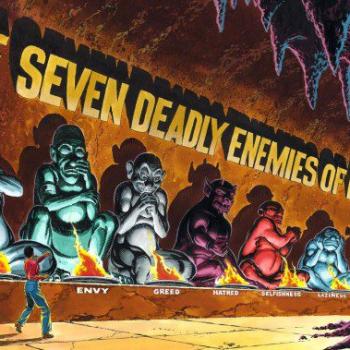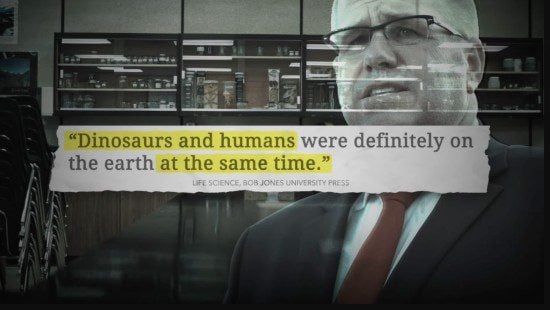The results from the annual Gallup survey on creationism are out, with the numbers right about where they’ve been for the past 30 years.
Finding yet again that 46 percent of Americans do not “believe” in evolution remains, to me, “dismaying.” (The link there is to my post responding to a similar survey in 2009. The results of the survey haven’t changed much, and neither has my reaction to them.)
Kevin Drum tries to console himself by exploring the idea that perhaps “The Fight Over Evolution Isn’t Actually All That Important.” Drum writes:
Belief in evolution has virtually no real-life impact on anything. That’s why 46 percent of the country can safely choose not to believe it: their lack of belief has precisely zero effect on their lives. Sure, it’s a handy way of saying that they’re God-fearing Christians — a “cultural signifier,” as Andrew [Sullivan] puts it — but our lives are jam-packed with cultural signifiers.
But “Creationism isn’t innocuous,” Amanda Marcotte responds. She quotes from PZ Myers, who says, “A well-informed citizenry is the only true repository of the public will.” Myers notes that “it’s our public schools that fill the pipeline leading” to our higher education biology departments and medical research labs, and that a rejection of science in those public schools certainly does have a very significant “real-life impact” on the ability to do the science we depend on.
Ryan Cooper weighs in, saying that “Science Denial Is a Large and Growing Problem.” He provides a concrete example of how a rejection of the facts of evolution is resulting in tangible harm:
A lack of wide understanding of evolution is hurting the country, most obviously in the form of antibiotic resistance. Industrial feedlots grow their animals stewed in powerful antibiotics to shave their operating costs, which is leading to bacteria evolving past them and resistant infections cropping up in humans. It’s a classic case of concentrated benefits and dispersed costs, which are tough to overcome in any case, but an understanding of evolution makes the situation immediately and alarmingly obvious, while disbelief can cloud the situation. Witness hack “scientists” at Liberty University, who publish work quibbling with the details of the evidence and thereby muddy the conversation. I’m not saying that’s the only factor, but surely if 80 percent of the country had a strong understanding of evolution, it would be easier to horsewhip the FDA into outlawing antibiotic use in non-sick animals.
I think my favorite response to Kevin’s post, though, comes from Katha Pollitt at The Nation. “What’s the Matter With Creationism?” she asks. Well, for one thing, it promotes a delusional, paranoid view of the world that requires tinfoil-hat belief in a global conspiracy of malicious scientists:
Rejecting evolution expresses more than an inability to think critically; it relies on a fundamentally paranoid worldview. Think what the world would have to be like for evolution to be false. Almost every scientist on earth would have to be engaged in a fraud so complex and extensive it involved every field from archaeology, paleontology, geology and genetics to biology, chemistry and physics. And yet this massive concatenation of lies and delusion is so full of obvious holes that a pastor with a Bible-college degree or a homeschooling parent with no degree at all can see right through it.
This is important. This “fundamentally paranoid” belief in a vast scientific conspiracy is not optional for belief in creationism. It’s a mandatory, necessary component of creationist ideology. To be a creationist — as 46 percent of Americans claim to be — means that you believe that universities, libraries and laboratories are evil places filled with evil people.
There’s no getting around it. Creationists may prefer not to think to much about the conspiratorial implications of what they’re arguing, but creationism just won’t work without the actual existence of such a “fraud so complex and extensive it involved every field from archaeology, paleontology, geology and genetics to biology, chemistry and physics.”
Consider, for example, this recent story: “Aboriginal rock art shown to Australian scientists dated at 28,000 years old.”
Human artifacts from 28,000 years ago are not something creationists can allow themselves to accept. They believe the universe itself is only 6,000 to 10,000 years old. So what do they make of this story?
Broadly speaking, creationists will respond with one of two theories. Either way, someone is lying to us. And either way, there’s a massive conspiracy aimed at deceiving us.
Theory No. 1 involves the global conspiracy of scientists Pollitt describes. This usually involves the claim that the carbon dating used on this rock art is unreliable. The theory — and I’m not joking here — is that scientists relying on carbon dating refuse to account for the way Noah’s flood accelerated the radioactive decay of carbon-14.
The conspiracy won’t admit this, because it would threaten their conspiratorial plot to profit from the lucrative teaching that the universe is more than 10,000 years old. All those archaeologists, paleontologists, geologists, biologists, chemists and physics Pollitt mentions must know this, but they refuse to admit it or to allow others to expose their secret.
So that’s the first theory: The scientists are lying. All of them.
Theory No. 2 doesn’t blame the scientists. It blames God. This conspiracy theory says that God is lying.
This involves some variation of the Omphalos hypothesis, meaning the belief that the apparent age of the world is not its actual age. The idea here is that God simply created the world to appear far older than it is.
The word “Omphalos” is Greek for “navel,” a reference to the idea that Adam and Eve were created as mature adults, complete with belly buttons. So too, the theory goes, God created the rest of the universe in a state of maturity, complete with relics — such as those belly buttons — of a past history that never actually occurred.
This theory has the merit of not being falsifiable. It is impossible to prove that the universe was not created 6,000-10,000 years ago and only appears 14 billion or so years older than that. The problem, of course, is that it is also impossible to prove that the universe was not created 6-10 minutes ago and only appears older than that. Hence the derogatory nickname of “Last Thursday-ism.” (Please don’t bother showing us that receipt from your breakfast last Wednesday. It proves nothing. When God created the universe last Thursday, God also in the same instant created you and your wallet, with that receipt already tucked in there next to your library card and your memories of that breakfast already tucked there inside your brain.)
There are variations of both of these theories but, generally speaking, those are the options for creationists. To believe in creationism, either you must believe that there is a global conspiracy of scientists intent on lying to you, or you must believe that God is intent on lying to you.
That 46 percent of Americans believe one or the other of those is, as I said, dismaying.












